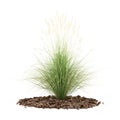Designed by
Title
Grass, plant #326292129
Description
Leaves: Grass leaves are typically long and narrow, with parallel veins running their length. The edges can be smooth or rough, depending on the species.Stems: Grass stems, also known as culms, are usually hollow except at the nodes, where leaves attach. Some species have solid stems.Roots: Grass roots are fibrous, forming dense mats that help in preventing soil erosion.Flowers: Grass flowers are small and usually grouped together in clusters called inflorescences, which can be spikelets, panicles, or racemes. These flowers are often wind-pollinated.Seeds: Grass seeds, known as grains, vary in size and shape and are often enclosed in a husk or hull.Ecological Role:Habitat: Grass can be found in a variety of habitats, including meadows, prairies, savannas, and wetlands. They dominate many ecosystems due to their adaptability and resilience.Soil Stabilization: Grass roots help bind soil particles together, reducing erosion and improving soil structure.Food Source: Grass is a primary food source for many herbivores, including livestock like cows, sheep, and goats, as well as wild animals like deer and antelope.Carbon Sequestration: Grasslands play a significant role in capturing and storing carbon dioxide, helping mitigate climate change.Types of Grass:Turfgrass: Used for lawns, sports fields, and golf courses (e.g., Kentucky bluegrass, Bermuda grass).Forage Grass: Grown for grazing animals or harvested as hay (e.g., Timothy grass, alfalfa).Cereal Grass: Cultivated for their edible grains (e.g., wheat, rice, corn, barley).Cultural and Economic Importance:Agriculture: Grass is vital in agriculture, not only for animal feed but also for crops like wheat, rice, and corn, which are staple foods worldwide.Landscaping: Grass is widely used in landscaping for aesthetic and recreational purposes, contributing to property value and community spaces.Environmental Benefits: Grasslands support biodiversity, water filtration, and carbon storage, providing significant ecological benefits.Challenges:Invasive Species: Some grass species can become invasive, outcompeting native vegetation and altering ecosystems.Overgrazing: Intensive grazing can lead to soil degradation and loss of grass cover, impacting both the environment and agriculture.

















